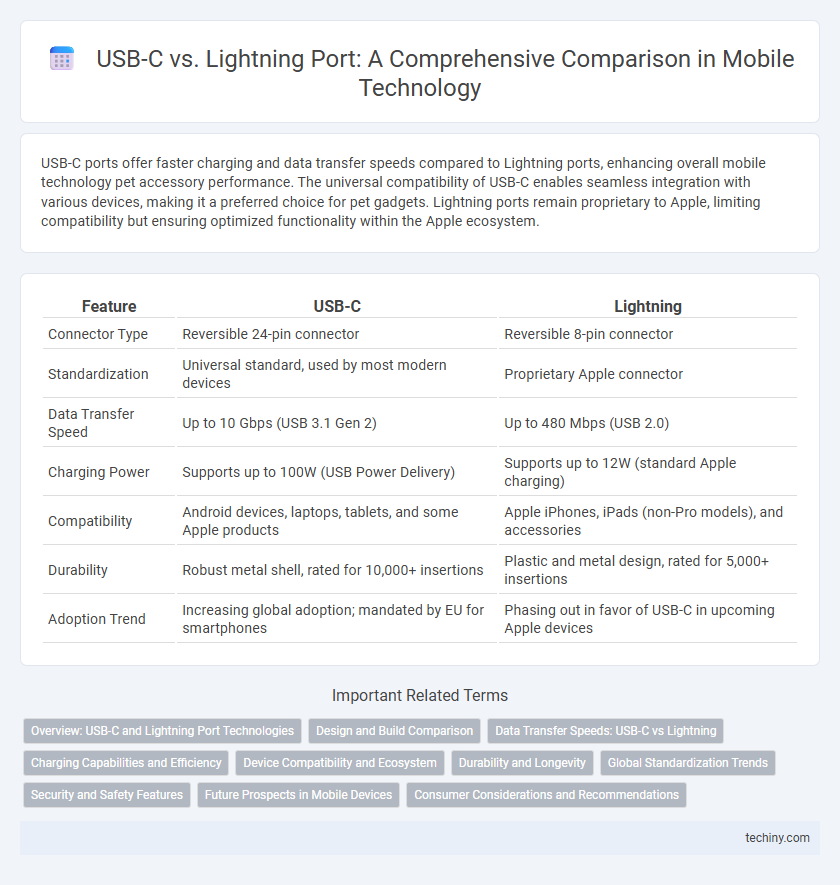USB-C ports offer faster charging and data transfer speeds compared to Lightning ports, enhancing overall mobile technology pet accessory performance. The universal compatibility of USB-C enables seamless integration with various devices, making it a preferred choice for pet gadgets. Lightning ports remain proprietary to Apple, limiting compatibility but ensuring optimized functionality within the Apple ecosystem.
Table of Comparison
| Feature | USB-C | Lightning |
|---|---|---|
| Connector Type | Reversible 24-pin connector | Reversible 8-pin connector |
| Standardization | Universal standard, used by most modern devices | Proprietary Apple connector |
| Data Transfer Speed | Up to 10 Gbps (USB 3.1 Gen 2) | Up to 480 Mbps (USB 2.0) |
| Charging Power | Supports up to 100W (USB Power Delivery) | Supports up to 12W (standard Apple charging) |
| Compatibility | Android devices, laptops, tablets, and some Apple products | Apple iPhones, iPads (non-Pro models), and accessories |
| Durability | Robust metal shell, rated for 10,000+ insertions | Plastic and metal design, rated for 5,000+ insertions |
| Adoption Trend | Increasing global adoption; mandated by EU for smartphones | Phasing out in favor of USB-C in upcoming Apple devices |
Overview: USB-C and Lightning Port Technologies
USB-C technology offers a universal standard for mobile devices, supporting faster data transfer rates up to 10 Gbps and power delivery up to 100W, making it ideal for charging and high-speed communication. Lightning ports, developed by Apple, provide a proprietary connection exclusively for iPhones and iPads, featuring an 8-pin design that supports efficient power delivery and data transfer but at slower speeds compared to USB-C. The shift towards USB-C in mobile technology emphasizes interoperability and enhanced performance across a wide range of devices and manufacturers.
Design and Build Comparison
The USB-C port features a symmetrical, reversible design that supports faster data transfer rates and higher power delivery compared to the Lightning port's smaller, proprietary connector. USB-C's robust metal casing enhances durability and compatibility across various devices, while Lightning ports rely on a slimmer profile tailored specifically for Apple products. The widespread adoption of USB-C promotes standardization in mobile technology, whereas Lightning remains limited to the Apple ecosystem.
Data Transfer Speeds: USB-C vs Lightning
USB-C offers significantly faster data transfer speeds compared to the Lightning port, supporting up to 10 Gbps with USB 3.1 Gen 2, while Lightning maxes out around 480 Mbps with USB 2.0. This difference makes USB-C ideal for transferring large files and high-resolution media between devices efficiently. Many modern smartphones and tablets are adopting USB-C to leverage these higher data transfer capabilities.
Charging Capabilities and Efficiency
USB-C ports support higher power delivery up to 100W, enabling faster charging speeds for smartphones and tablets compared to Lightning ports, which typically max out around 12W to 20W. The USB Power Delivery (USB PD) protocol used in USB-C allows for dynamic power adjustments, enhancing charging efficiency and battery longevity. Lightning ports, proprietary to Apple, have slower data transfer rates and limited power scalability, making USB-C the preferred choice for modern mobile devices seeking optimal charging performance.
Device Compatibility and Ecosystem
USB-C offers broad device compatibility, supporting a wide range of smartphones, tablets, laptops, and accessories across multiple brands and ecosystems. The Lightning port remains exclusive to Apple devices, creating a more closed ecosystem but ensuring seamless integration within Apple's product lineup. Choosing USB-C enhances cross-platform connectivity, while Lightning maintains optimized performance within Apple's tightly controlled environment.
Durability and Longevity
USB-C ports exhibit superior durability compared to Lightning ports due to their reinforced connectors and standardized design, which support up to 10,000 insertion cycles. Lightning ports, designed by Apple, have a slightly lower endurance rate and can wear out faster under frequent use. The robust construction of USB-C enhances device longevity by reducing port damage and maintaining consistent data and power transfer over time.
Global Standardization Trends
USB-C is rapidly becoming the global standard for mobile device charging and data transfer due to its universal compatibility, faster charging speeds, and support for higher data rates. Governments and regulatory bodies, such as the European Union, are pushing for USB-C adoption to reduce electronic waste and enhance consumer convenience. In contrast, Apple's proprietary Lightning port remains limited to its ecosystem, facing growing pressure to transition toward USB-C for future mobile devices.
Security and Safety Features
USB-C offers enhanced security protocols such as secure authentication and encrypted data transfer, which reduce vulnerability to malicious accessories compared to Apple's Lightning port. The Lightning port, while compact, lacks some of the built-in security measures found in USB-C, making it more susceptible to unauthorized device access. USB-C's robust power delivery standards also ensure safer charging by preventing overheating and overcurrent issues, providing a more reliable safety profile for mobile devices.
Future Prospects in Mobile Devices
USB-C is rapidly becoming the standard charging and data transfer port for mobile devices due to its universal compatibility and faster charging capabilities. Apple's gradual shift from Lightning to USB-C in recent iPhone models highlights a significant industry trend toward a single connector standard. Future mobile devices are expected to adopt USB-C widely, enhancing interoperability and supporting emerging technologies like faster data rates and increased power delivery.
Consumer Considerations and Recommendations
Consumers choosing between USB-C and Lightning ports should prioritize device compatibility, charging speed, and data transfer rates, with USB-C offering broader interoperability across smartphones, tablets, and laptops. Lightning ports remain prevalent in older Apple devices, but USB-C's faster power delivery and universal adoption in Android and newer Apple products make it the preferred option for future-proofing. Evaluating device ecosystem, accessory availability, and charging needs ensures an informed decision tailored to individual usage patterns.
USB-C vs Lightning port Infographic

 techiny.com
techiny.com